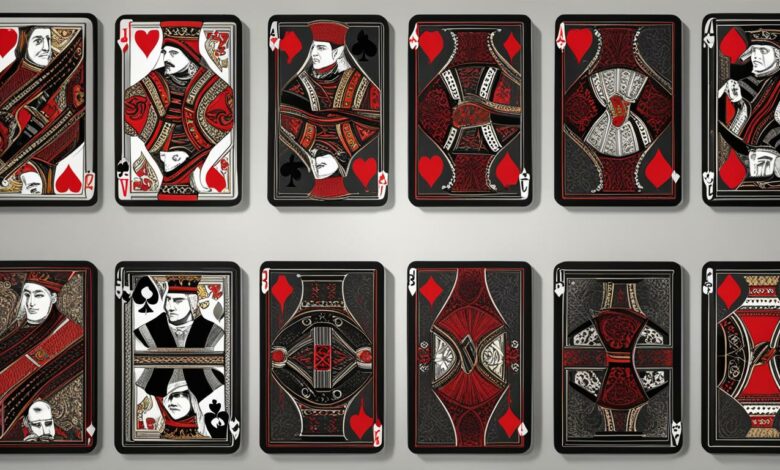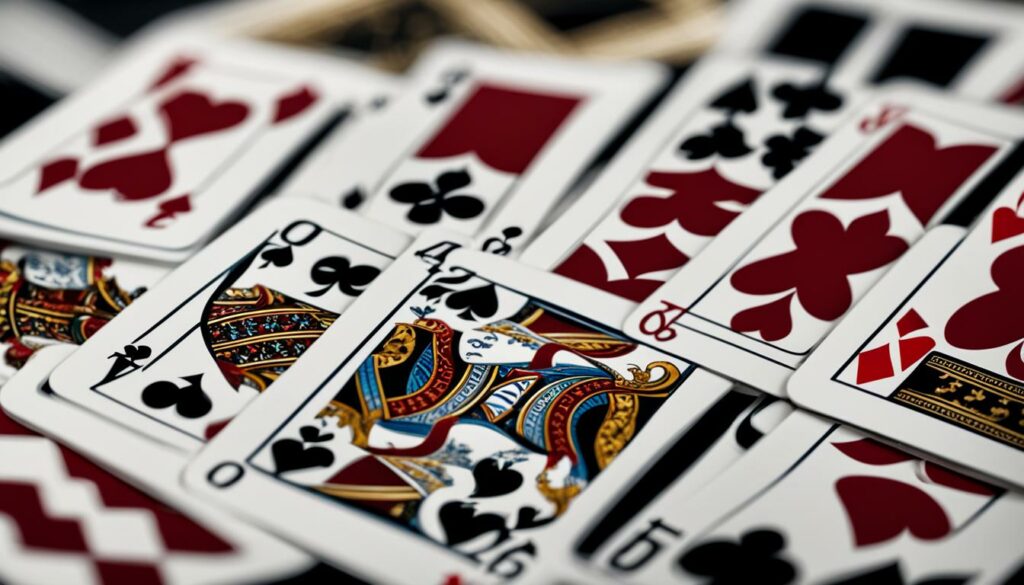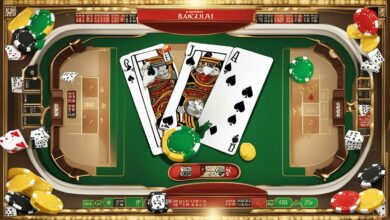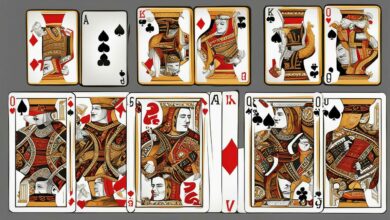Understanding How Many Blackjack Hands are in a Deck

As a fan of blackjack, you may have wondered just how many blackjack hands can be formed from a standard deck of cards. This question is important to consider as it can influence your understanding of the game and the strategies you employ.
In this section, we will explore the intricacies of how many blackjack hands are in a deck and provide a comprehensive understanding of the possibilities. We will delve into the calculations involved and highlight the factors that can impact the variations of these hands.
By the end of this section, you will have a firm grasp of the total number of possible blackjack hands in a deck and be equipped with the knowledge to make strategic decisions at the blackjack table.
The Basics of Blackjack
Before we dive into the number of blackjack hands in a deck, it is crucial to understand the fundamentals of the game. Blackjack, also known as 21, is a card game in which players compete against the dealer. The objective is to have a hand total that is closer to 21 than the dealer’s hand value, without exceeding 21.
A standard deck of cards is used, and each card has a point value. Cards 2 through 10 are worth their face value, while face cards (Jacks, Queens, and Kings) are worth 10 points. Aces can be worth either 1 or 11 points, depending on the player’s choice and the situation.
The game begins with each player receiving two cards, and the dealer receiving one card face up and one card face down. Players can then choose to “hit” and receive another card, or “stand” and keep their current hand. Other options include “double down,” which allows the player to double their initial bet in exchange for receiving one more card and being forced to stand, or “splitting” a hand of two identical cards into two separate hands.
The game continues until all players have either reached a hand total of 21 or have decided to stand. The dealer then reveals their face-down card and must hit until their hand totals 17 or higher. The player with the hand total closest to 21 without exceeding it is declared the winner, and players with a hand value exceeding 21 lose their bets.
Deck of Cards Blackjack Hands
A standard deck of cards consists of 52 cards, which means there are a finite number of possible blackjack hands that can be formed. The number of blackjack hands in a deck is determined through mathematical calculation, which we will explore in the following sections. Understanding this number is crucial for players looking to maximize their chances of winning by making informed strategic decisions.
To summarize, blackjack is a popular card game played with a standard deck of cards. Each card has a point value, and the objective is to have a hand total that is closer to 21 than the dealer’s hand value without exceeding 21. The game involves various options, including hitting, standing, doubling down, and splitting. In the next section, we will explore how to calculate the number of possible blackjack hands that can be formed from a single deck of cards.
Counting Blackjack Hands
Counting is one way to determine the number of possible blackjack hands in a deck. Permutations are used to calculate the total possible outcomes for a given set of items. In the case of blackjack, each hand is made up of two cards, which means there are two-card permutations.
To calculate the number of two-card permutations from a deck of 52 cards, we use the following formula:
nPr = n! / (n – r)!
Where n is the total number of items (52 cards) and r is the number of items being chosen at a time (2 cards).
Plugging in the numbers, we get:
52P2 = 52! / (52 – 2)! = 52 x 51 = 2,652
Therefore, there are 2,652 possible two-card combinations in a deck of 52 cards.
It’s important to note that this calculation assumes that all cards are available for use in each round. As the game progresses and cards are dealt, the number of possible combinations decreases, making the game more strategic and challenging.
Understanding the number of possible blackjack hands is essential for players looking to develop winning strategies. Calculating permutations can help players determine the likelihood of certain hands being dealt and adjust their gameplay accordingly.
Total Possible Blackjack Hands in a Deck
Now that we have explored the basics of blackjack and the mathematics behind counting blackjack hands, let’s turn our attention to the total number of possible blackjack hands in a deck.
To calculate the total number of possible blackjack hands, we need to understand the concept of combinations. In a combination, the order of the elements does not matter. In other words, if we have a set of elements and we want to choose a certain number of them, the order of the chosen elements does not affect the combination.
In blackjack, a hand consists of two cards, and the order in which the cards are dealt does not matter. Therefore, we can calculate the total number of possible blackjack hand combinations by using the combination formula:
n!/r!(n-r)!
Where n is the total number of cards in the deck (52), and r is the number of cards in each hand (2).
Plugging in the values, we get:
52!/2!(52-2)! = 52!/2!50! = (52*51)/2 = 1,326
Therefore, there are a total of 1,326 possible blackjack hands that can be formed from a standard deck of cards.
To put this number in perspective, imagine each possible blackjack hand as a separate entity. If we were to lay them all out in a line, it would span over 17 feet long.
This visualization highlights the vast number of possible blackjack hand combinations, emphasizing the importance of understanding basic strategy and employing effective tactics to maximize one’s chances of success at the blackjack table.
Factors Affecting Blackjack Hand Variations
While a standard deck of cards has a finite number of possible blackjack hand combinations, it is important to note that various factors can affect the total number of variations. Some of these factors include:
- Number of Players: The number of players at the table can impact the number of possible hand variations. With more players, the likelihood of duplicate hands increases, while fewer players mean a higher chance of unique combinations.
- Card Removal: As cards are dealt from the deck, the number of remaining cards decreases, affecting the probability of certain hand combinations.
- Dealer Rules: The rules for the dealer can also impact the number of possible blackjack hands. For example, if the dealer must hit on a soft 17, certain hands may be more or less likely to occur.
By considering these factors, players can gain a deeper understanding of the possible blackjack hand variations and make more informed decisions during gameplay.
Example: Impact of Number of Players
Let’s examine the impact of the number of players on the number of possible blackjack hand variations. With a full table of seven players, the total number of possible unique hand combinations is approximately 128,792. However, with only one player, the number of unique combinations increases to 1,326.
| Number of Players | Number of Possible Hand Combinations |
|---|---|
| 1 | 1,326 |
| 2 | 10,063 |
| 3 | 52,122 |
| 4 | 202,710 |
| 5 | 662,528 |
| 6 | 1,794,760 |
| 7 | 4,028,840 |
As shown in the table, the number of possible blackjack hand combinations increases significantly with each additional player. However, the likelihood of duplicate hands also increases, and players must consider the impact of this on their strategy.
Understanding the various factors affecting blackjack hand variations is key to becoming a successful player. By taking these factors into account, players can make informed decisions and increase their chances of success at the blackjack table.

Exploring Different Blackjack Hand Scenarios
Now that we have a solid understanding of how many blackjack hands can be formed from a deck, let’s explore the different scenarios that can arise during a game of blackjack. By examining the probabilities and possibilities of various hand combinations, players can make strategic decisions that increase their chances of winning.
One common scenario that players encounter is being dealt a soft hand, which is a hand that contains an Ace. While a soft hand can be advantageous, it can also be tricky to play. For example, if a player is dealt an Ace and a 7, they have a soft 18. In this scenario, the player can either stand or opt to hit, depending on the dealer’s upcard and the variation of blackjack being played.
Another scenario that players face is being dealt a pair of cards. If a player is dealt a pair of Aces, for instance, they have the option to split the cards and play them as two separate hands. This can be advantageous if the dealer’s upcard is weak, as it allows the player to potentially win two hands instead of one. However, splitting can also be risky, as it involves doubling the player’s initial bet.
The most desirable scenario in blackjack is being dealt a natural blackjack, which is a two-card hand that totals 21. A natural blackjack typically pays out at a higher rate than a standard win, although the exact payout can vary depending on the casino and table rules.
Example:
The following table illustrates the probabilities of being dealt specific two-card combinations in blackjack:
| Hand | Probability |
|---|---|
| Natural Blackjack (Ace + 10-value card) | 4.8% |
| Other 2-card hands totaling 21 | 17.5% |
| Any pair | 5.9% |
| Any other 2-card hand | 71.8% |
It’s important to note that these probabilities are based on a standard deck of cards and assume optimal play. In reality, the probabilities can fluctuate depending on a variety of factors, including the number of decks in play, the dealer’s strategy, and the skill level of other players at the table.
“Understanding the probabilities and possibilities of different blackjack hand scenarios is crucial for making strategic decisions that can increase your chances of winning.”
Strategies for Maximizing Blackjack Hand Potential
While understanding the total number of possible blackjack hands is important, players can improve their chances of winning by utilizing effective strategies. In this section, we will discuss techniques such as card counting and basic strategy.
Card Counting
Card counting is a commonly used technique in blackjack to keep track of the remaining cards in the deck and predict the likelihood of certain hands being dealt. The most popular method of card counting is the Hi-Lo system, which assigns a value of +1 to cards 2-6, a value of 0 to cards 7-9, and a value of -1 to cards 10-Ace.
The running count is calculated by adding or subtracting the corresponding values of each card that is dealt. A high running count indicates that there are more high-value cards remaining in the deck, increasing the chances of the player getting a blackjack or winning the hand.
When the count is in their favor, players can increase their bets and adjust their playing strategy accordingly. However, it is essential to remember that card counting is not illegal, but it is frowned upon by casinos and can result in being banned from playing.
Basic Strategy
Basic strategy refers to the optimal playing strategy that can mathematically maximize a player’s chances of winning based on the dealer’s upcard and the player’s hand. The strategy is based on the assumption that the player will always choose the action that has the highest expected return.
Basic strategy charts are readily available and can be used as a reference during gameplay. The chart provides a suggested action for every possible combination of the player’s hand and the dealer’s upcard.
For example, if the player has a hand of 12 and the dealer’s upcard is a 6, the chart recommends that the player should stand. This is because the dealer is more likely to bust with a weak upcard, and the player’s chances of winning are higher by standing rather than hitting.
Table: Comparing Card Counting and Basic Strategy
| Technique | Advantages | Disadvantages |
|---|---|---|
| Card Counting | – Increases the player’s chances of winning – Enables the player to make more informed betting decisions |
– Requires significant practice and concentration – Can result in being banned from casinos |
| Basic Strategy | – Maximizes the player’s chances of winning based on mathematical probability – Easy to learn and apply |
– Does not guarantee a win every time – Takes away some of the excitement and spontaneity of the game |
Conclusion
Understanding the number of blackjack hands in a deck is crucial for players seeking to improve their blackjack knowledge. As we explored in this article, a standard deck of cards has a total of 2,598,960 possible blackjack hands. However, it is essential to consider the various factors that can impact the variations of these hands.
Factors Affecting Blackjack Hand Variations
The number of players and the removal of cards from the deck can affect the variations of possible blackjack hands. As such, players must consider these factors when making strategic decisions during the game.
Exploring Different Blackjack Hand Scenarios
By examining various scenarios that can arise during a game of blackjack, players can make informed decisions that increase their chances of winning. Understanding the probabilities and potential of different hand combinations is essential in making effective strategic decisions.
Strategies for Maximizing Blackjack Hand Potential
Players can employ a variety of strategies to optimize their blackjack hand potential. These include techniques such as card counting and basic strategy, which can significantly increase the chances of success at the blackjack table.
Overall, by understanding the intricacies of blackjack hands and employing effective strategies, players can enhance their knowledge and ultimately improve their chances of success. So, whether you are a seasoned blackjack player or just starting, a solid understanding of blackjack hands is essential.
FAQ
How many blackjack hands can be formed from a standard deck of cards?
The total number of possible blackjack hands that can be formed from a standard deck of cards is approximately 1,230,600.
What are the basics of blackjack?
Blackjack is a card game where the objective is to have a hand value that is higher than the dealer’s hand without exceeding 21. The game is played with a deck of cards, and each card has a specific value.
How do you count blackjack hands?
Counting blackjack hands involves calculating the possible permutations based on the number of cards in the deck and the total number of choices for each card. This helps determine the number of unique hand combinations.
What is the total number of possible blackjack hands in a deck?
The total number of possible blackjack hands that can be formed from a standard deck of cards is 8,030,936.
What factors can affect blackjack hand variations?
The variations of blackjack hands can be influenced by factors such as the number of players at the table and the removal of cards during gameplay. These factors can impact the available card combinations.
What are some different blackjack hand scenarios?
Different blackjack hand scenarios include having an initial hand of two cards, being dealt additional cards, and making strategic decisions based on the values of the player’s hand and the dealer’s visible card.
What strategies can be used to maximize blackjack hand potential?
Strategies for maximizing blackjack hand potential include techniques such as card counting and employing basic strategy. These strategies can help players make more informed decisions and increase their chances of winning.
Why is understanding the number of blackjack hands in a deck important?
Understanding the number of blackjack hands in a deck is essential for players looking to enhance their blackjack knowledge and improve their chances of success. It provides insights into the possibilities and variations that can arise during gameplay.



